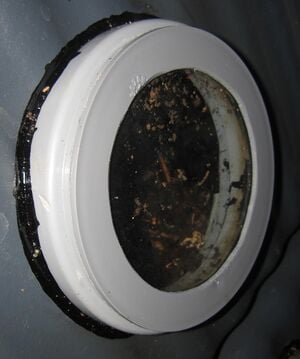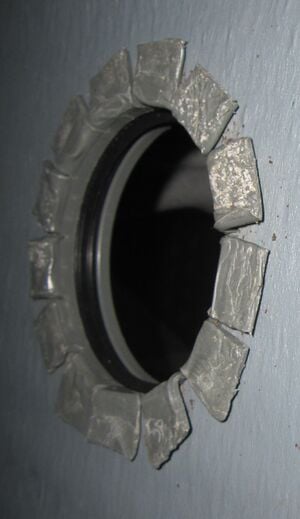
This article describes the prototype of a compost heater silo, which is the heart of an internal Compost heater, in an early development state.
The prototype on the photograph on the right has been build by modifying a usual rainwater tank (polyethylen). It is 1.80 m high at a volume of 300 liters. This is too small for a substantial contribution for the heating requirements of a regular dwelling house, however its purpose is the analysis and optimization of the system's behavior, a feasibility study.
The prototype has an inlet for the biomass and an outlet for the resulting compost. There are 5 additional glass windows for observation and possible manual intervention. The air inlet and outlet are made from HT waste water pipes (polypropylen). Ports for water heating have been prepared, but are not yet used.
The prototype was started in October 2017 in a frost-free garage. After a one year trial the prototype was modified and moved into the basement of a dwelling house, where the conditions are nearly the same as in the intended use.
Start of the First Trial[edit | edit source]
Biomass filled in: shredded bush, foliage, bio waste from the kittchen. Two buckets of half rotten compost were added to give the decay process a good start. This included many invertebrates who multiplied thereafter:
- Redworm
- Common rough woodlouse
- Land slug
First Experiences[edit | edit source]


- The air permeability of the biomass is good enough, even without special means to increase it. The initially built in grids have been removed after a few weeks.
- The surrounding temperature is important. The decay slows down below 10°C, which is caused by the slim shape of the silo in this case. The heat is too easily radiated by the large surface.
- The moistness must be high enough to support the microbes optimal. The biomass should be dripping wet.
- The air ventilation does not work with the own convective pressure in this prototype. This again can be due to the slim shape. Therefore, an additional gentle push is required. Placing the air outlet on an appropriate location of the roof is good enough, letting the wind pressure do the work.
- If thuja or other biomass with strong aromatic oils is put in, the microbial activity is impeded and the temperature declines. This effect is subject to further studies. It may be useful for pausing the decay process during the warm summer months.
- Egg shells are not decayed, because the pH level is nearly neutral.
Modifications after the First Trial[edit | edit source]
The prototype was modified in July 2018 to make it ready for the second winter. All ports have been reinforced by a waste water coupler and carefully sealed. An additional pipe has been fed through the silo for water heating. The silo has been placed in a warmer location in a dwelling house, where the surrounding conditions are nearly the same as in the intended use. The air inlet has been corrected to the breather pipe of an existing waste water canal.
Experiences with the Silo inside the Dwelling House[edit | edit source]
- The energy conversion rises, when the silo is wrapped in some layers of blankets. The temperature rises and the microbes feel better.
- Every day the silo segregates about 250 ml water, allowing an estimation of the energy conversion rate (ca. 40 W).
- Small flies (fruit flies perhaps) have started to make a living in the silo. When you open the lid, they gush out and into the living room, which is annoying. So, the gadget is not really good for everyday food waste disposal.
- Removal of the compost is not necessary in any case, because the decay process is continued down to water, dissolved minerals and carbon dioxide if the moisture is high enough. However, the energy conversion rate declines when the consistence of the biomass reaches the regular soil particle size, which it does several month after the start. So, the finished soil should be taken out before new biomass is filled in before the next winter.